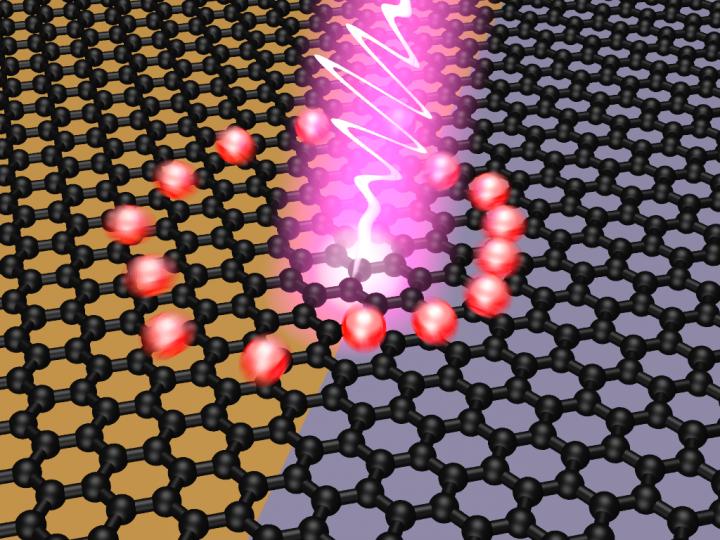Graphene photodetector speeds up light-to-electricity conversion
April 15, 2015

An illustration of ultrafast photovoltage creation after light absorption at the interface of two graphene areas with different energy levels (credit: ICFO/Achim Woessner)
Researchers at MIT, UC Riverside, and ICFO have demonstrated a graphene-based photodetector that converts absorbed light into an electrical voltage in an extremely short time*.
The finding opens up a new path to ultra-fast optoelectronic (light to electricity and vice versa) conversion, which is essential for faster data transmission, and to photodetectors that operate over a broad range of frequencies.
To demonstrate this, researchers used a combination of ultrafast pulse-shaped laser excitation and highly sensitive electrical readout.
Photovoltage generation through the photothermoelectric (PTE) effect occurs when light is focused at the interface of
monolayer and bilayer graphene, which are doped to have different Fermi energies.
The study was published in Nature Nanotechnology. It was funded by the E.C. under Graphene Flagship, an NWO Rubicon fellowship, an ICFO-Cofund fellowship, The Fundacio Cellex Barcelona, the ERC, and the MIT MISTI-Spain program.
* Less than 50 femtoseconds (5×10-14 seconds).
Abstract of Generation of photovoltage in graphene on a femtosecond timescale through efficient carrier heating
Graphene is a promising material for ultrafast and broadband photodetection. Earlier studies have addressed the general operation of graphene-based photothermoelectric devices and the switching speed, which is limited by the charge carrier cooling time, on the order of picoseconds. However, the generation of the photovoltage could occur at a much faster timescale, as it is associated with the carrier heating time. Here, we measure the photovoltage generation time and find it to be faster than 50 fs. As a proof-of-principle application of this ultrafast photodetector, we use graphene to directly measure, electrically, the pulse duration of a sub-50 fs laser pulse. The observation that carrier heating is ultrafast suggests that energy from absorbed photons can be efficiently transferred to carrier heat. To study this, we examine the spectral response and find a constant spectral responsivity of between 500 and 1,500 nm. This is consistent with efficient electron heating. These results are promising for ultrafast femtosecond and broadband photodetector applications.